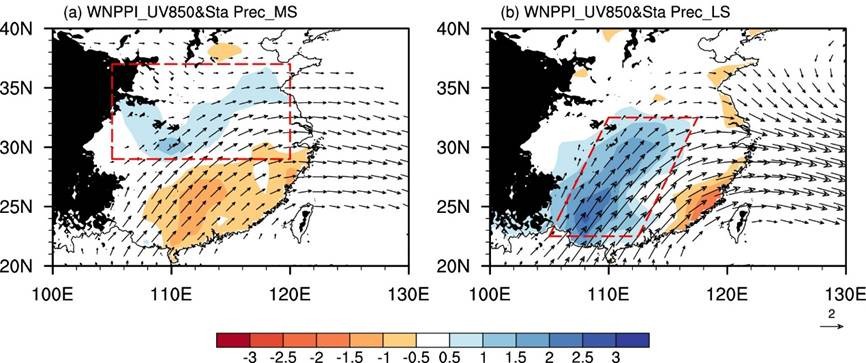State Key Laboratory of Numerical Modeling for Atmospheric Sciences and
Geophysical Fluid Dynamics (LASG)
Institute of Atmospheric Physics, Chinese Academy of Sciences

Vol.9/No9. April 2019
Scientists Find Seesaw Pattern of Rainfall Anomalies between the Tropical Western North Pacific and Central Southern China during Late Summer
Summer rainfall over eastern China is significantly affected by anomalous convective activity over the tropical western North Pacific (WNP). Suppressed convection (or precipitation) over the tropical WNP induces an anticyclonic anomaly in the lower troposphere to the northwest. This anticyclonic anomaly corresponds to a westward extension of the WNP subtropical high and favors enhanced rainfall along the climatological East Asian rain band by modifying water vapor transport. There is always good correspondence between the circulation and rainfall anomalies: the rainfall anomalies always appear at the north flank of the subtropical WNP anticyclonic/cyclonic anomaly.
However, recent research conducted by Dr. LI Xinyu and Professor LU Riyu, from the Institute of Atmospheric Physics, Chinese Academy of Sciences, shows an exception. During late summer, the rainfall anomalies appear at the west flank of the subtropical WNP anticyclonic anomaly, i.e., central southern China, including the middle reaches of the Yangtze River and Pearl River.

Wind anomalies at 850 hPa (vectors; units: m s−1) and precipitation anomalies (shading; units: mm d−1) associated with suppressed convection over the tropical western North Pacific during (a) mid-summer and (b) late summer
"The uniqueness of late summer is related to the dramatic change in climatological monsoon flows. The southerlies over southern China during early and middle summer are replaced by easterlies during late summer. Therefore, the anomalous anticyclone, which shows a southerly anomaly over southern China, enhances monsoonal southerlies and induces more rainfall along the rain band during early and middle summer. During late summer, however, it changes the path, rather than the intensity, of monsoon flows,” explains Dr. LI, the lead author of the study.
Professor LU adds: “The special rainfall pattern over the middle reaches of the Yangtze River and Pearl River—the two largest rivers in China—would further exert an influence on the hydrological conditions and ecosystems of their middle and lower reaches. It is therefore necessary to pay more attention to this rainfall pattern.”
The findings are published in Advances in Atmospheric Sciences.
Citation: Li, X. Y., and R. Y. Lu, 2019: Seesaw pattern of rainfall anomalies between the tropical western North Pacific and central southern China during late summer. Adv. Atmos. Sci., 36(3), 261–270, https://doi.org/10.1007/s00376-018-8130-6
Contact: LU Riyu, lr@mail.iap.ac.cn
E-mail: lasg_newsletter@lasg.iap.ac.cn
Editors: Chuanyi Wang (wangcy@lasg.iap.ac.cn), Kangjun Chen(ckj@lasg.iap.ac.cn)